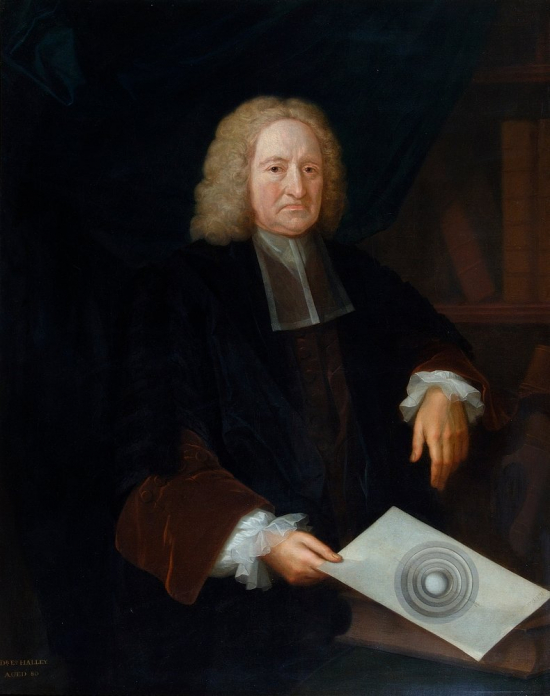If there are many distinct celestial spheres above our heads, why couldn’t there be just as many under our feet?
The ideas of Isaac Newton were deeply rooted in the study of alchemy and astrology. In Book III of his Principia the founding father of physics – maybe following some esoteric theory – made a gross mistake: his calculations led him to conclude that the Moon was denser than the Earth, and not just a little – the ratio was 9 to 5!
His contemporaries were aware that this was a blunder, yet generously remained silent about this matter of the ultra-dense Moon. Ultimately, it was just a detail within a vast and revolutionary work. But there was a scholar who, starting from this mistake, formulated an extraordinary theory.
This scholar was the astronomer Edmond Halley (1656–1742), who is still well known today because of the comet that bears his name. As early as in 1683 Halley had assumed that the terrestrial magnetic poles weren’t just two but four: this idea was supposed to explain a series of anomalies found in compasses – variations that had long been debated within the scientific community (Descartes had expressed his opinion about them as well). Halley had his intuition precisely as he was reading once again the mistake in Newton’s Principia: the astronomer wondered how the Moon, in spite of being so small, could almost be twice as dense as the Earth. Instead of questioning this fact, he concluded that the Earth should be hollow. Or, rather, he hypothesised that the Earth’s surface, which was 800 kilometres thick, might hide two more concentric crusts, perpetually rotating inside it, separated by atmospheric gases. One last sphere was at the centre, the core of our planet.
This theory, published in 1692, could explain magnetic anomalies, because the displacement of subterranean poles would certainly make any compass go haywire. Well aware of the oddity of his theory, Halley tried to anticipate some counter-arguments. How could these spheres keep the right position without touching each other? This obviously depended on gravity –after all, weren’t Saturn’s rings hovering in mid-air as well? And had the outer crust cracked, wasn’t there a risk that an ocean disappear in the cavity below? There should be – Halley replied – some Saline and Vitriolick Particles that instantly turned the water to stone, preventing it from leaking into the lower layers. In addition to such conjectures, Halley added a sentence to his treatise, which in the following centuries would make sci-fi writers happy, “I have adventured to make these
Subterranean orbs capable of being inhabited. It was impossible not to be enthralled by these words. This is how an adventurous literary current was born, which would include contributions by writers such as Holberg, Casanova, Poe, and Verne.
Different authors have described inner worlds as utopian landscapes inhabited by beings of infinite wisdom, or on the contrary as infernal places inhabited by cruel and fighting people. Blending with ancient and modern myths, they have become the location of the legendary lost city of Agartha, the secret base from which flying saucers leave, the homeland of fantastic prehistoric beings... Even out of book pages somebody looked (in vain) for tunnels to access the lower spheres, passages that would be hidden at the North Pole, on the Himalaya or in other spiritually significant spots.
Edmond Halley remained sure that his theory was correct until the end of his days.
For example, when on March 6th, 1716, a great part of North-western Europe witnessed spectacular Northern Lights, in an article for the Royal Society Halley connected them with the leakage of glowing gases coming from inner worlds.
In 1736, when he was already in his eighties, the Royal Astronomer was portrayed with a diagram of the hollow Earth in his hand. That portrait honours him in a sense: although not in a way he would expect, his idea of underground continents indelibly marked our collective imagination.

